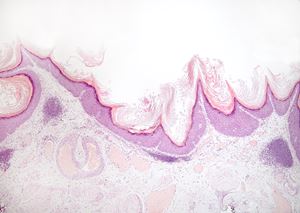CASE OF THE WEEK
2019-34 / OCTOBER 14
(CONTRIBUTOR: JONATHAN EPSTEIN)
A 70 year old man underwent a TURB for a large hyperkeratotic lesion involving the entire bladder. The lesion could not be totally resected with only partial sampling performed.
Quiz
What is the correct diagnosis?
a. Verrucous carcinoma
b. Condyloma accuminatum
c. Keratinizing verrucous hyperplasia
d. Low grade papillary urothelial carcinoma with squamous differentiation
1. c
1. Keratinizing verrucous hyperplasia
Keratinizing squamous metaplasia in general, especially if extensive, is associated with an increased risk of squamous cell carcinoma. In this case the entire bladder was filled with an shaggy lesion that microscopically was composed of pointed spikey projections of benign squamous mucosa with extensive superficial keratin formation.
Condylomas would have complex rounded papillary formation with fibrovascular cores along with viral cytopathic affect. Verrucous carcinomas would have broad-based bulbous papillae with marked acanthosis extending deeper that the adjacent benign epithelium.
In-situ hybridization studies for high-risk and low-risk HPV performed at Johns Hopkins Hospital were negative. It was recommended that since complete excision was not feasible due to the extent of the lesion, the options included repeat cystoscopies and biopsies are recommended or cystectomy. There is limited data on the prognosis of verrucous squamous hyperplasia. In a study we performed, of the 5 patients with verrucous squamous hyperplasia, 1 patient had invasive squamous cell carcinoma at cystectomy at an interval of 14 months, 1 had squamous cell CIS on rebiopsy, 1 had persistent verrucous squamous hyperplasia on rebiopsy, and 2 had no evidence of disease at 6 and 24 months. We are in the process of studying a larger cohort of these cases.
Guo CC, Fine SW, Epstein JI. Noninvasive squamous lesions in the urinary bladder: a clinicopathologic analysis of 29 cases.
Am J Surg Pathol. 2006 Jul;30(7):883-91.
Jonathan Epstein
Johns Hopkins Hospital
jepstein@jhmi.edu
Bladder
Verrucous squamous hyperplasia





